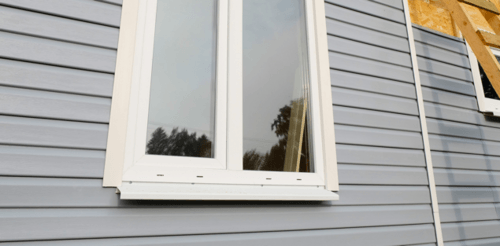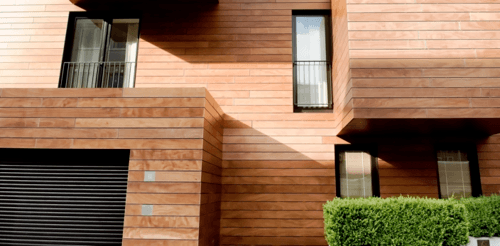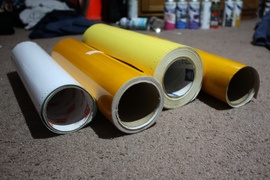Vinyl vs Wood Siding
Vinyl Siding
$5,500 - $7,000
(1,500 sq.ft. vinyl siding installed)
VS
Wood Siding
$10,000 - $11,000
(1,500 sq.ft. cedar siding installed)
Cost varies greatly by region (and even by zip code).
To get free estimates from local contractors, please indicate yours.
Vinyl Siding

- Easy to install
- Lower maintenance than wood
- Does not require painting
- Many styles and colors available
- Unaffected by moisture or humidity
- Can be used with foam insulation
- Durable - lasts for 40 years
- Less affected by insects
- Inexpensive
- Cracks in cold weather
- Melts when exposed to heat
- May detract from resale
- Not environmentally friendly
- Fewer options for appearance
(1,500 sq.ft. vinyl siding installed)
Get free advice and estimates from siding contractors in your city.
Wood Siding

- Wide range of style options
- Many installation choices
- Not affected by extreme temperatures
- Has good ROI - maintains value
- More eco-friendly
- Lasts 20 to 40 years
- Susceptible to wood-eating insects
- Higher maintenance
- Requires painting/scraping
- More difficult to insulate
- Impacted by moisture
- Harder to install
- More expensive
(1,500 sq.ft. cedar siding installed)
Get free advice and estimates from siding contractors in your city.
The exterior of your home plays an important role in its value. A well-maintained exterior not only enhances the appearance of the home, but it also affects how people first view the property. This first look is known as curb appeal, and it can have a lot to do with how quickly a home sells and how much it sells for.
When maintaining your curb appeal, the siding plays a big part. This includes not only how the siding looks and what style it is, but also what the material is. Two of the most popular materials for re-siding a home include wood and vinyl 1. Both have positive and negative attributes that may make you decide on one over the other. We outline the differences between them below, helping you make the right choice for your home.
Appearance
Both wood and vinyl siding are available in a range of different styles, which customizes the look of your home’s exterior. This includes traditional, horizontal lap siding, shingles 2, and in some cases, decorative siding.
Of the two, wood is definitely more versatile. It can be found in different plank sizes and may be installed in a shiplap or board-and-batten style. Shingles may be installed in straight or irregular patterns. Vinyl siding is more limited in style selection as well as plank sizes and how those planks are installed.
From a distance, both may provide a wood-grain finish to the siding. However, real wood is actually slightly more subtle in the appearance of the grain than the faux grain of vinyl. In addition, vinyl siding has seams where one plank overlaps the next, which are slightly more visible than that of wood siding because wood planks tend to sit flush together rather than overlap.
Energy-Efficiency
With no insulation behind either material, wood siding is slightly more energy-efficient, having an R-value of 0.81 to 0.87. Vinyl siding without insulation has an R-value of 0.67. This is negligible, however, as a fully insulated exterior should have an R-value of 13.
Vinyl siding can have foam insulation put behind it, which increases its R-value to 3 or 4. However, if vinyl is being used as a rainscreen, it cannot have insulation in this area. To truly insulate the home, foam panel insulation should be considered beneath any siding because the siding itself does not insulate.
Installation
Of the two materials, vinyl siding is faster and easier to install. The planks and even the shingles are designed to lock into one another without fasteners 3. The material does not need to be sanded, primed, or painted, and it cuts easily with a pair of shears. Once the bottom row is nailed into place, the remaining rows can be locked together as the installation proceeds up.
Wood siding is nailed into place, which takes longer to install. The boards must be cut with a saw and are usually primed and painted just before installation, which increases the amount of labor necessary to complete the job.
Costs
Of the two siding materials, vinyl is much less expensive than wood. Vinyl siding costs around $2 a square foot installed, while wood costs around $7 on average. Different wood species, as well as different styles of the siding, may affect the costs. Insulation costs around $1 a square foot, while new sheathing and housewrap run an additional $1 to $2 a square foot. Disposing of the old siding costs another $1,000 to $2,000 depending on the material.
For a 1,500-square-foot home, vinyl siding costs between $5,500 and $7,000, installed. Wood siding replacement costs for the same size home are around $10,000 to $11,000, assuming no major issues are found.
Maintenance
While neither material can be truly called low maintenance, vinyl requires less maintenance than wood. Wood siding peels over time, which means that it must be scraped and repainted regularly to prevent issues such as wood rot.
Vinyl siding does not require sanding, scraping, or repainting, so it can be considered lower maintenance than wood. The material has drawbacks from a maintenance standpoint, however, including the fact that the boards may easily detach and drop off the house, requiring them to be put back on frequently. Boards may also crack or warp, which means that they need to be replaced.
Durability
If wood siding is maintained every five years or so, it can last for 20 to 40 years or more. However, if not well-maintained, its lifespan decreases because rot could set in.
Vinyl can easily last 40 or more years, making it more durable in terms of longevity.
Pests
Wood siding is often susceptible to some types of wood-eating insects or pests. Some types of wood siding are less vulnerable than others, and the wood may be treated to help prevent this.
Vinyl siding is not susceptible to damage from wood-eating insects or pests because it is made from a type of plastic. If there are gaps in the vinyl, however, pests may still enter and eat the home’s wood frame where it is less noticeable.
Sound Performance
Neither wood nor vinyl is considered particularly soundproof. No siding will make a significant change in the amount of sound that you hear. Cladding an ICF block home with either wood or vinyl siding or using some type of foam insulation beneath the siding can have a significant reduction in sound for your home, but putting either siding over a wood frame will not.
Extreme Temperatures
When it comes to temperature changes, wood swells and contracts slightly with humidity in the air. For areas that see extreme humidity changes, this could eventually warp the wood.
Vinyl is not impacted by humidity, but it is affected by temperature. Vinyl siding cracks in extreme cold. It can also grow brittle and crack as it ages in areas that see extreme highs and lows throughout the year. In locations with high temperatures, the material may soften and melt. This is true of any type of heat, whether from the sun, a grill placed too close, or light reflecting off a nearby window coated with low-emissivity (Low-E). In some cases, the vinyl siding can melt a small amount and warp, and in severe cases, it may require complete replacement.
Environmental Concerns
Of the two materials, wood is slightly better for the environment. When harvested with good forest protection plans, wood has a lower impact on the environment than vinyl. This is because wood siding can be easily disposed of and will not sit in landfills for years.
Vinyl is a type of plastic, so during its manufacturing, it can release harmful chemicals into the air as well as use enormous amounts of energy to produce it. While it can be recycled, it is very difficult to find recycling centers that accept it. So, leftover material or old siding often sits in landfills, without breaking down.
Resale Value
According to Remodeling Magazine’s Cost vs Value Report, a siding replacement will recoup about 76% at the time of resale, but they do not specify which material. However, in some areas, vinyl may get less of a return than wood, while in other areas vinyl, may actually lower the value of a home if it replaced wood siding.
Remodeling Terms Cheat Sheet
Definitions in laymen's terms, cost considerations, pictures and things you need to know.See full cheat sheet.
 1 Vinyl: A synthetic plastic made from ethylene and chlorine. Vinyl has many applications in the construction industry and it is widely used in sidings, window frames, roofing and gutters, among others
1 Vinyl: A synthetic plastic made from ethylene and chlorine. Vinyl has many applications in the construction industry and it is widely used in sidings, window frames, roofing and gutters, among others
 2 Shingles: A smooth, uniform, flat piece of construction material, available in a wide variety of materials and laid in a series of overlapping rows, used to cover the outside of roofs or walls to protect against weather damage and leaks.
2 Shingles: A smooth, uniform, flat piece of construction material, available in a wide variety of materials and laid in a series of overlapping rows, used to cover the outside of roofs or walls to protect against weather damage and leaks.
How much does it cost in my city?
Cost varies greatly by region (and even by zip code).
To get free estimates from local contractors, please indicate yours.